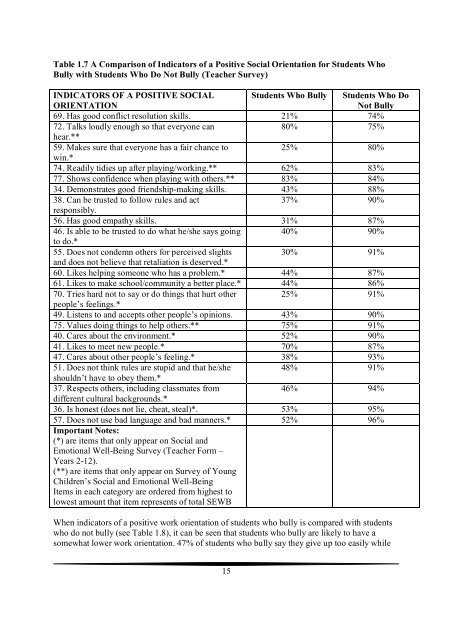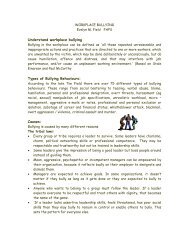The social and emotional wellbeing of students who bully different ...
The social and emotional wellbeing of students who bully different ...
The social and emotional wellbeing of students who bully different ...
You also want an ePaper? Increase the reach of your titles
YUMPU automatically turns print PDFs into web optimized ePapers that Google loves.
Table 1.7 A Comparison <strong>of</strong> Indicators <strong>of</strong> a Positive Social Orientation for Students WhoBully with Students Who Do Not Bully (Teacher Survey)INDICATORS OF A POSITIVE SOCIALORIENTATIONStudents Who Bully Students Who DoNot Bully69. Has good conflict resolution skills. 21% 74%72. Talks loudly enough so that everyone can80% 75%hear.**59. Makes sure that everyone has a fair chance to25% 80%win.*74. Readily tidies up after playing/working.** 62% 83%77. Shows confidence when playing with others.** 83% 84%34. Demonstrates good friendship-making skills. 43% 88%38. Can be trusted to follow rules <strong>and</strong> act37% 90%responsibly.56. Has good empathy skills. 31% 87%46. Is able to be trusted to do what he/she says going 40% 90%to do.*55. Does not condemn others for perceived slights30% 91%<strong>and</strong> does not believe that retaliation is deserved.*60. Likes helping someone <strong>who</strong> has a problem.* 44% 87%61. Likes to make school/community a better place.* 44% 86%70. Tries hard not to say or do things that hurt other25% 91%people’s feelings.*49. Listens to <strong>and</strong> accepts other people’s opinions. 43% 90%75. Values doing things to help others.** 75% 91%40. Cares about the environment.* 52% 90%41. Likes to meet new people.* 70% 87%47. Cares about other people’s feeling.* 38% 93%51. Does not think rules are stupid <strong>and</strong> that he/she48% 91%shouldn’t have to obey them.*37. Respects others, including classmates from46% 94%<strong>different</strong> cultural backgrounds.*36. Is honest (does not lie, cheat, steal)*. 53% 95%57. Does not use bad language <strong>and</strong> bad manners.* 52% 96%Important Notes:(*) are items that only appear on Social <strong>and</strong>Emotional Well-Being Survey (Teacher Form –Years 2-12).(**) are items that only appear on Survey <strong>of</strong> YoungChildren’s Social <strong>and</strong> Emotional Well-BeingItems in each category are ordered from highest tolowest amount that item represents <strong>of</strong> total SEWBWhen indicators <strong>of</strong> a positive work orientation <strong>of</strong> <strong>students</strong> <strong>who</strong> <strong>bully</strong> is compared with <strong>students</strong><strong>who</strong> do not <strong>bully</strong> (see Table 1.8), it can be seen that <strong>students</strong> <strong>who</strong> <strong>bully</strong> are likely to have asomewhat lower work orientation. 47% <strong>of</strong> <strong>students</strong> <strong>who</strong> <strong>bully</strong> say they give up too easily while15









